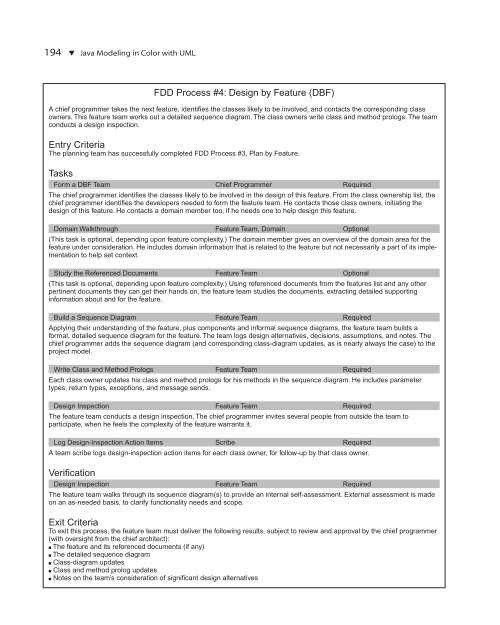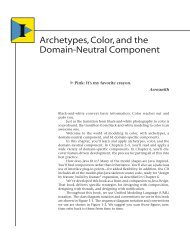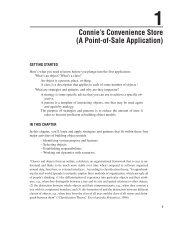Feature-Driven Development - About Peter Coad
Feature-Driven Development - About Peter Coad
Feature-Driven Development - About Peter Coad
Create successful ePaper yourself
Turn your PDF publications into a flip-book with our unique Google optimized e-Paper software.
194 ▼ Java Modeling in Color with UML<br />
FDD Process #4: Design by <strong>Feature</strong> (DBF)<br />
A chief programmer takes the next feature, identifies the classes likely to be involved, and contacts the corresponding class<br />
owners. This feature team works out a detailed sequence diagram. The class owners write class and method prologs. The team<br />
conducts a design inspection.<br />
Entry Criteria<br />
The planning team has successfully completed FDD Process #3, Plan by <strong>Feature</strong>.<br />
Tasks<br />
Form a DBF Team Chief Programmer Required<br />
The chief programmer identifies the classes likely to be involved in the design of this feature. From the class ownership list, the<br />
chief programmer identifies the developers needed to form the feature team. He contacts those class owners, initiating the<br />
design of this feature. He contacts a domain member too, if he needs one to help design this feature.<br />
Domain Walkthrough <strong>Feature</strong> Team, Domain Optional<br />
(This task is optional, depending upon feature complexity.) The domain member gives an overview of the domain area for the<br />
feature under consideration. He includes domain information that is related to the feature but not necessarily a part of its implementation<br />
to help set context.<br />
Study the Referenced Documents <strong>Feature</strong> Team Optional<br />
(This task is optional, depending upon feature complexity.) Using referenced documents from the features list and any other<br />
pertinent documents they can get their hands on, the feature team studies the documents, extracting detailed supporting<br />
information about and for the feature.<br />
Build a Sequence Diagram <strong>Feature</strong> Team Required<br />
Applying their understanding of the feature, plus components and informal sequence diagrams, the feature team builds a<br />
formal, detailed sequence diagram for the feature. The team logs design alternatives, decisions, assumptions, and notes. The<br />
chief programmer adds the sequence diagram (and corresponding class-diagram updates, as is nearly always the case) to the<br />
project model.<br />
Write Class and Method Prologs <strong>Feature</strong> Team Required<br />
Each class owner updates his class and method prologs for his methods in the sequence diagram. He includes parameter<br />
types, return types, exceptions, and message sends.<br />
Design Inspection <strong>Feature</strong> Team Required<br />
The feature team conducts a design inspection. The chief programmer invites several people from outside the team to<br />
participate, when he feels the complexity of the feature warrants it.<br />
Log Design-Inspection Action Items Scribe Required<br />
A team scribe logs design-inspection action items for each class owner, for follow-up by that class owner.<br />
Verification<br />
Design Inspection <strong>Feature</strong> Team Required<br />
The feature team walks through its sequence diagram(s) to provide an internal self-assessment. External assessment is made<br />
on an as-needed basis, to clarify functionality needs and scope.<br />
Exit Criteria<br />
To exit this process, the feature team must deliver the following results, subject to review and approval by the chief programmer<br />
(with oversight from the chief architect):<br />
■ The feature and its referenced documents (if any)<br />
■ The detailed sequence diagram<br />
■ Class-diagram updates<br />
■ Class and method prolog updates<br />
■ Notes on the team’s consideration of significant design alternatives




